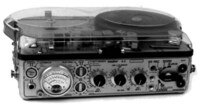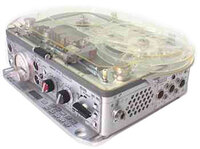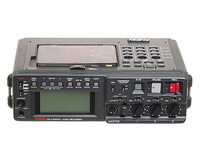![]() Today's Production Sound Mixer faces a choice: to record the production dialogue in single track (monaural), 2-track, 4-track, or even 8-12 track. In this article, based on Fred Ginsburg's popular live lectures during NAB 2010, the author presents a brief overview of multi-track recording for film and video production.
Today's Production Sound Mixer faces a choice: to record the production dialogue in single track (monaural), 2-track, 4-track, or even 8-12 track. In this article, based on Fred Ginsburg's popular live lectures during NAB 2010, the author presents a brief overview of multi-track recording for film and video production.
 For most of Hollywood’s past, Production Sound was recorded live to just one track (monaural). The various location recorders (optical and magnetic) varied throughout the decades, and culminated with the legendary Nagra 4.2 sync recorder.
For most of Hollywood’s past, Production Sound was recorded live to just one track (monaural). The various location recorders (optical and magnetic) varied throughout the decades, and culminated with the legendary Nagra 4.2 sync recorder.
The craft of production sound recording consisted of mixing audio acquired by multiple mics (boom1, boom2, planted mics, and lavaliers) into one cohesive soundtrack (the production track). This live mixed soundtrack would serve as the audio for dailies, and then later for the picture editor’s versions.
After the editor declared that the picture cut was “locked”, the sound editors would begin to work their magic. The single soundtrack would first be split (checker boarded) onto multiple tracks so that each actor and sound effect could be treated individually (volume adjustments, EQ, etc.) Glitches such as pops, clicks, and other audibles would be removed. If the dialogue was deemed unusable, then ADR would be ordered. Ditto for sound effects and Foley.
Two Track as opposed to Stereo
It wasn’t until the early 1980’s that we began using two-track on location as the norm. True, there had been some early pioneering with 8 and 16 tracks by directors such as Altman. However, the monaural Nagra 4.2 was still the industry standard. But with the emergence and rapid industry acceptance of the new Nagra IV-STC stereo time code recorder, Hollywood entered the age of two track recording.
 Note that I use the term TWO TRACK, and not STEREO. It is important to make this distinction. On location, we do not generally think in terms of left and right (aka stereo) as one might in live music recording.
Note that I use the term TWO TRACK, and not STEREO. It is important to make this distinction. On location, we do not generally think in terms of left and right (aka stereo) as one might in live music recording.
The term stereo refers to capturing the left side and right side components of a sound, so that when they are reproduced out of a pair of left side and right side speakers, or headphones – the listener will have a sense of left and right balance or space. Sounds may originate on the left or right of the listener, and may even travel (“pan”) across from one side to the other, or just park somewhere in between hard left and hard right.
Stereo is what happens when we listen to music, or a fully mixed movie. It is the finished result for the enjoyment of the audience.
But stereo is rarely recorded as such in the field. Instead, we record monaural sounds and wait until post-production is nearly complete to re-assign these sounds to the audience’s left, right, and in-between.
 Until the film is edited, there is no way to know just where all of the audio elements need to end up. For instance, out on production, it might seem logical to record a car that passes from left to right in stereo, so that you can hear the “pass by” in your phones whoosh from the left ear to the right ear.
Until the film is edited, there is no way to know just where all of the audio elements need to end up. For instance, out on production, it might seem logical to record a car that passes from left to right in stereo, so that you can hear the “pass by” in your phones whoosh from the left ear to the right ear.
If the movie only consisted of that one angle of the car, with no intercuts, then your stereo track would be quite usable. However, in the real world, that car-by is likely to be covered from a multitude of camera angles, and then intercut with a multitude of close-ups and insert shots. Many (if not most) of this additional footage will represent screen center (as opposed to the wide shot of the car travelling from screen left to screen right).
As the finished sequence is built by the editor, it might start with a long shot of a car coming towards the screen, some left to right angles, maybe some more dead-on angles, some shots of the driver, inserts of gas pedals, shifter knobs, angles on the passenger, sheriff’s car lurking, woman with baby carriage about to cross the street, and…. You can see where this is going: it is certainly not a simple pan the sound from left to right situation. The editor would not want the audio to ping pong rapidly from screen left, to center, to left, to right, back to center, etc. The flow of the audio has to be paced with the changing perspectives of the shots; with full audio pans carefully and strategically employed for full effect, but not as meaningless distraction!
The solution is to record all of the sounds as monaural (center screen); and to let the editors re-mix and re-assign those sounds to various surround positions during post-production. Also, keep in mind that professional films are not two-track stereo presentations, but are at the least, surround sound six-track (aka 5.1 surround). Audio has to be positioned amongst screen left, screen center, screen right, surround rear left, surround rear right, and sub-woofer effect!
Therefore, if we are recording in two-track in the field, we do not think in terms of left track and right track. Instead, rename these connectors (in your head) as Track One and Track Two. You have two places to store the recorded audio; and the audio in these two places should be different, so that the editor has maximum flexibility to select/adjust one track over the other.
Microphones could be split across the two tracks so as to avoid phasing issues, such as when a boom mic might overlap a lavalier. Or, two lavaliers could be mixed to two different tracks in order to minimize noise, prevent phasing, and balance volume levels.
In some cases, track one could be a live mix, while track two serves as an iso of an important actor’s radio mic.
